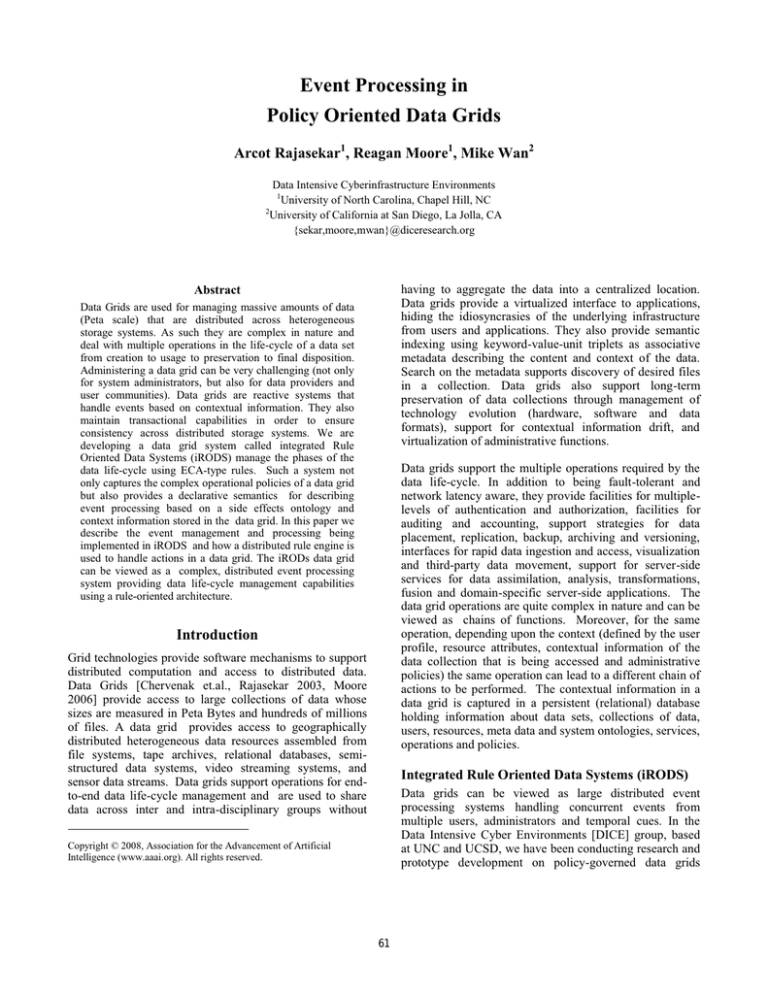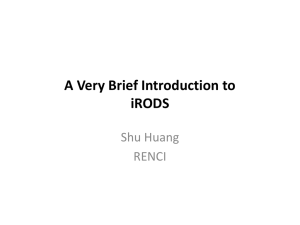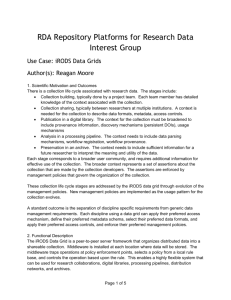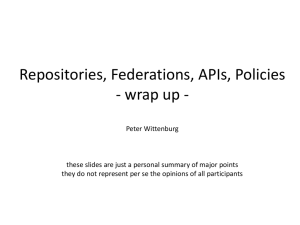
Event Processing in
Policy Oriented Data Grids
Arcot Rajasekar1, Reagan Moore1, Mike Wan2
Data Intensive Cyberinfrastructure Environments
1
University of North Carolina, Chapel Hill, NC
2
University of California at San Diego, La Jolla, CA
{sekar,moore,mwan}@diceresearch.org
having to aggregate the data into a centralized location.
Data grids provide a virtualized interface to applications,
hiding the idiosyncrasies of the underlying infrastructure
from users and applications. They also provide semantic
indexing using keyword-value-unit triplets as associative
metadata describing the content and context of the data.
Search on the metadata supports discovery of desired files
in a collection. Data grids also support long-term
preservation of data collections through management of
technology evolution (hardware, software and data
formats), support for contextual information drift, and
virtualization of administrative functions.
Abstract
Data Grids are used for managing massive amounts of data
(Peta scale) that are distributed across heterogeneous
storage systems. As such they are complex in nature and
deal with multiple operations in the life-cycle of a data set
from creation to usage to preservation to final disposition.
Administering a data grid can be very challenging (not only
for system administrators, but also for data providers and
user communities). Data grids are reactive systems that
handle events based on contextual information. They also
maintain transactional capabilities in order to ensure
consistency across distributed storage systems. We are
developing a data grid system called integrated Rule
Oriented Data Systems (iRODS) manage the phases of the
data life-cycle using ECA-type rules. Such a system not
only captures the complex operational policies of a data grid
but also provides a declarative semantics for describing
event processing based on a side effects ontology and
context information stored in the data grid. In this paper we
describe the event management and processing being
implemented in iRODS and how a distributed rule engine is
used to handle actions in a data grid. The iRODs data grid
can be viewed as a complex, distributed event processing
system providing data life-cycle management capabilities
using a rule-oriented architecture.
Data grids support the multiple operations required by the
data life-cycle. In addition to being fault-tolerant and
network latency aware, they provide facilities for multiplelevels of authentication and authorization, facilities for
auditing and accounting, support strategies for data
placement, replication, backup, archiving and versioning,
interfaces for rapid data ingestion and access, visualization
and third-party data movement, support for server-side
services for data assimilation, analysis, transformations,
fusion and domain-specific server-side applications. The
data grid operations are quite complex in nature and can be
viewed as chains of functions. Moreover, for the same
operation, depending upon the context (defined by the user
profile, resource attributes, contextual information of the
data collection that is being accessed and administrative
policies) the same operation can lead to a different chain of
actions to be performed. The contextual information in a
data grid is captured in a persistent (relational) database
holding information about data sets, collections of data,
users, resources, meta data and system ontologies, services,
operations and policies.
Introduction
Grid technologies provide software mechanisms to support
distributed computation and access to distributed data.
Data Grids [Chervenak et.al., Rajasekar 2003, Moore
2006] provide access to large collections of data whose
sizes are measured in Peta Bytes and hundreds of millions
of files. A data grid provides access to geographically
distributed heterogeneous data resources assembled from
file systems, tape archives, relational databases, semistructured data systems, video streaming systems, and
sensor data streams. Data grids support operations for endto-end data life-cycle management and are used to share
data across inter and intra-disciplinary groups without
Integrated Rule Oriented Data Systems (iRODS)
Data grids can be viewed as large distributed event
processing systems handling concurrent events from
multiple users, administrators and temporal cues. In the
Data Intensive Cyber Environments [DICE] group, based
at UNC and UCSD, we have been conducting research and
prototype development on policy-governed data grids
Copyright © 2008, Association for the Advancement of Artificial
Intelligence (www.aaai.org). All rights reserved.
61
6.
called the integrated Rule-Oriented Data Systems
[Rajasekar 2006, iRODS, Moore 2007]. IRODS is adaptive
middleware that provides a flexible, extensible and
customizable data management architecture by encoding
operations as workflow functions that are defined by
sequences of micro-services. The work flow functions can
be interpreted as policies and are encoded as user-defined
and/or administrator-defined ECA-type rules [Dayal 1996].
The “semantics” (or side effects) of a functionality can be
decided by users or data providers within limits imposed
by the system administrators. Hence, changes to a
particular process or policy can be easily constructed by
the user and tested and deployed without the aid of system
and application developers. The user can also define
conditions when these rules get triggered thus controlling
application of different rules and rule sets based on current
events and operating conditions.
7.
A Messaging Server that can be used for
communications between micro-services running
in parallel or at different times.
A Rule Scheduler which can schedule rule
invocations. The scheduler can also be used for
delaying operations or for asynchronous
execution.
Figure 1 provides an architectural diagram for the iRODS
system. Figure 2 provides a servic-level diagram of the
iRODS system.
iRODS rules are invoked either by client operations
(events such as ingestion of a new file, access to a copy of
a file, etc) or by temporal cues or by events that are
triggered by changes in the state of the iCAT persistent
database. The distributed rule engine fires the rules at the
storage location of the data and executes the relevant
micro-services. The micro-services can check for
conditions, change the metadata state or perform an
operation such as replicating a file, or broadcasting an
email, etc. The Administrative interface (under
development) will provide a means for defining rules (a
rich rule language supports atomic, deferred, and periodic
execution of hierarchical rule sets), checking for rule base
consistency, and managing other aspects of the data
management system.
The programming of rules in iRODS can be viewed as
lego-block type programming. The building blocks for the
iRODS are micro-services - small, well-defined
procedures/functions that perform a certain task. Users and
administrators “chain” micro-services to implement a
larger macro-level functionality (as rules) to be executed
on triggered events. The rules can be published for use by
others. For example, one may encode a rule that when
accessing a data object from a collection named “B”,
additional authorization checks need to be made. These
authorization checks can be encoded as a set of additional
rules with different triggers that can fire based on current
operating conditions. In this way, one can control access to
sensitive data based on rules and can escalate or reduce
authorization levels dynamically as the situation warrants.
The iRODS rule engine design builds upon the application
of theories and concepts from a wide range of well-known
paradigms from fields such as active databases,
transactional systems, logic programming, business rule
systems, constraint-management systems, workflows,
service-oriented architecture and program verification.
The iRODS prototype has been developed based on our
experience in building and deploying a first generation data
grid system called the Storage Resource Broker [SRB].
The SRB manages collections in a wide variety of domains
from bioinformatics, to astronomy sky surveys, to
earthquake simulations, to sensor data streams. It has been
shown to scale to petabytes of data with 100s of millions of
files. The main drawback of the SRB was the use of hardcoded data management policies. If a user wanted to
perform complex sets of operations on datasets, they had to
program at the client level and move the data from the
server to perform the operation. IRODS obviates the need
for this through its flexible rules and micro-services
allowing operations to be performed at the data server.
We have implemented a prototype of the iRODS system.
The system consists of the following components:
1. A three-layer peer-to-peer server system that
interfaces to a remote client on one side and the
storage and data providers at the other side. The
middle layer implements the intelligence of the
system through explicit rules and micro-services.
2. An iCAT catalog system based on a relational
database. Mechanisms are provided to access the
database using its native API while exposing
higher-level functions that can be used to interact
with the iCAT catalog.
3. A rule engine that interprets rules from a rule base
and executes micro-services.
4. A rich set of Client-side APIs and utilities.
5. An administration utility.
Event-driven Data Management
Distributed data management is normally viewed as a set
of operations (such as get, put, remove, etc) that are
performed on datasets residing at remote sites. In iRODS,
we took a different approach and viewed the operations as
occurring within a distributed event-based system. Our
view takes the following principles in defining the
operations that are performed by a data grid:
Copyright © 2008, Association for the Advancement of Artificial
Intelligence (www.aaai.org). All rights reserved.
62
1.
2.
3.
4.
5.
6.
7.
8.
d.
an operation is a triggering event that can result
in different actions based on the context in which
the event occurs.
An event triggers a sequence of actions and can
trigger additonal events.
Events are coded as ECA-type rules (called
iRODS rules) that use a guard condition “C” to
check the context for application. . The actions
“A” are called micro-services (in the current
proto-type they are C-language functions) that
have well-defined semantics attributed to them. In
particular, they provide an external semantics
based on the side-effects they cause in the outside
world as well as in state information changes
within the iCAT persistent database.
Departing from normal ECA semantics, only one
iRODS rule per event can succeed. The rules are
prioritized and applied in a specified order and the
rule invocation completes when an ECA rule
succeeds. (if needed, there is syntax sugar in the
language which all allows application of all rules)
Extending ECA semantics, an iRODS rule is
transactional in nature: it leaves the distributed
system in the samestate as before if the action
sequence fails at any part. This is necessary to
make sure that the data grid is not left in an
unstable state. To enable this transactional nature,
every micro-service used in a rule is associated
with a recovery micro-service. Most of the sideeffects can be rolled back except for a few
external effects that will be discussed later. With
this, we have an extended ECAR type of rule (R
standing for recovery). In relational databases
transactional properties are handled with commits
and rollbacks, even extending them into triggers.
But in the case of a data grid, because of the
complexity of operations involved, and the
diversity of the side effects, explicit recovery is
needed.
An event can trigger sub-events (also encoded as
iRODS rules) and hence one can look at the
operational semantics as a hierarchical event tree.
Operationally the sub-events and actions can
happen serially, in parallel, in a distributed
execution environment and/or in a time-delayed
mode.
Micro-services can communicate with each other
in multiple ways:
a. Using parameter passing
b. Using a white-board which holds the
local execution context. The white board
can be ported or checkpointed for
execution by a remote micro-service or
for delayed execution.
c. Using the global status and contextual
information stored in the persistent iCAT
database.
9.
Using a messaging system to transmit
serialized messages. This way dataflow
and workflow operational characteristics
can be applied.
The set of iRODS rules that are applied is
normally fixed for each session for a user
connection to the iRODS system. But flexibility is
built into the system that can allow different sets
of rules to be used for different users and groups.
Hence a data grid can apply one set of rules for
the seismic community and another set for the
astronomy community.
With the above principles in mind, we defined a rule
system with rules of the form:
A :- C | M1, …, Mn | R1, …, Rn
where A is the name triggering event,
C is the guard condition for the rule to fire
Mi is a micro-service or a rule, and
Ri is a recovery micro-service.
The checking of the guard condition may not change the
state of the system, but only evaluate the context as defined
by the white-board, parameters and results of iCAT
database queries. When more than one rule is defined for
an event, the rules are tried in a pre-defined priority order.
The first rule whose guard condition succeeds is applied
and its sequence of micro-services/sub-events is executed.
If any of the micro-services fail, the recovery microservices are executed. Then, the rest of the rules are
checked for applicability repeating the process.
As an example, consider an ingestion event, where a new
dataset is being uploaded into the iRODS data grid. There
is a sequence of actions that need to be performed for the
data to be store in the grid. First, the user’s permission for
performing the action in the data collection needs to be
checked, then the users permission to store the file in a
particular physical location is checked, then depending
upon the type and size of the file, a data movement
protocol is selected (to do the move in paralllel, in multiple
hops by staging , etc). and then finally the dataset is stored
into the system. Then the information about this new
addition is entered into the iCAT database with
information about its physical location, its logical name,
ownership, size, type, etc. Moreover, if other events are
triggered by this ingestion (such as extraction of metadata,
replication of the data into other distributed resources, or
performance of some transform or integrity check) these
events can lead to more rules being fired and actions taken
therewith. We show below a simpler (example rule) that
can be used for such an ingestion event where contextual
information plays a role. In this case, the context is based
on either a user group or because of the type of data being
ingested. [Many of the details of the parameters are not
shown for clarity purposes. In each of the rules, the first
defines the event and the guard condition, the second line
shows the action sequence and the third the recovery action
sequence.]
63
perform replication checks or integrity checks), or queued
events in the messaging system (workflow operations on a
file based on flagged status messages). The iRODS system
has many rules coded for firing based on different types of
events. These rules range from events of the data life-cycle
such as ingest, remove, copy, move, replicate, trim,
archive, synchronize, modify, change access permission,
relocate, stage, purge, etc. They can also involve events
that are associated with a single dataset or a collection such
as extract metadata, resize or change resolution of an
image, transform a document (eg., Word to pdf), snapshot
a table, etc. They can also involve events in data grid
administration such as adding, and removing users,
modifying user profile, creating a new resource, removing
an existing resource, migrating files from one resource to
another, backing up a resource, etc. . In a full-fledged data
grid system such as the SRB there were more than one
hundred such operational events that were identified. They
were initiated by specific commands that a user or
administrator could execute in the SRB system.
(a) OnIngest :- userGroup == astro
| findResource, storeFile, registerInIcat, replicateFile
| nop, removeFile, rollback, unReplicate.
(b) OnIngest :- userGroup == seismic && size > 1GB
| findTapeResource, storeFile, registerInIcat, seisEv1
| nop, removeFile, rollback.
(c) OnIngest :- userGroup == seismic && size <= 1GB
| findTinyResource, storeFile, registerInIcat, seisEv2
| nop, removeFile, rollback.
Rule (a) is applied for users within user group “astro”.
When a file is put into the data grid, a storage resource is
selected, the file is stored, the state information is
registered into the iCAT catalog, and the file is replicated.
Note that this can be a sequence of images from a
telescope that is being ingested.
Rule (b) is applied for users within user group “seismic”
for file sizes greater than 1 Gigabyte. When a file is put
into the data grid, a tape storage system is selected, the file
is stored, the state information is registered into the iCAT
catalog, and an additional micro-service called “seisEv1” is
executed. This might trigger a delayed or asynchronous
action on the newly ingested file such as extraction of
metadata, searching for some seismic markers, etc. The
input may consist of a stream of packets from a sensor
network.
Micro-Services and iRODS Rules
Micro-services are the building blocks of the iRODS
system. They can be viewed as defining the Action part in
an ECA-type rule. As described above, micro-services
communicate with each other and with the process
environment using four different communication models.
The semantics of a micro-service can be captured based on
the change-semantics that it encodes. The semantics of
micro-services are based on three types of properties that
hold before and after the execution of a micro-service:
Rule (c ) is also applied for users within user group
“seismic”, but for files smaller than 1 Gigabyte. When a
file is put into the data grid, a “small” storage system is
selected, the file is stored, the state information is
registered into the iCAT catalog, and an additional microservice called “seisEv2” is executed.
1) A micro-service can modify the value of variables
and structures in the white board it shares in the
execution environment with other micro-services.
2) A micro-services can insert, delete or update the
values in the tables in the iCAT database.
3) A micro-service can have side-effects outside the
iRODS system (eg. creation of a new file in a file
system).
One might define another event as shown below which is
triggered after ingestion of an image to extract astronomy
metadata using a template called “astroTemplate”. The
descriptive metadata is loaded as attributes for the image
and stored in the iCAT catalog for subsequent query and
discovery operations.
The white board is shared only during that particular rule
execution. Note that a rule can fire other rules in a
hierarchical fashion. The white board can be shared across
two sequential rule invocations provided the data grid
“uses” the same white-board for the second rule. The white
board can be packed and passed to remote servers for use
in their micro-service execution. Serializability of the
hierarchical execution of micro-services is an important
criteria needed for establishing the semantics of the
distributed execution environment. We denote the status of
the white board using the symbol $ (dollar).
(d) OnNewFile :- Collection == astroColl
| extractMetadata (astroTemplate,M), ingestICat(M).
| nop, rollback.
(e) OnNewFile :- Collection == astroColl
| sendEmail(astroCollOwner)
In the above case, when a new file is registered into the
iCat, the OnNewFile event triggers application of the rules
(d). If (d) fails for some reasons, then (e) fires and an email
is sent to the collection owner about the failure.
The iCAT is a persistent database, hence any changes
made to it are seen not only by other micro-services in the
current rule execution, but also by other rules excuted
locally or remotely, and by rules and micro-services
executed at a later time period. We rely on the relational
The triggering events in iRODS can be either user
generated (ingest a single file or a collection of files), or
dynamically generated from the iCat database (periodically
64
database transactional properties for maintaining the
stability and recoverability of the iRODS operations. We
denote the status of the iCAT database using the symbol %
(percent).
RS: {%, #} rule {%’, #’}
The Event semantics of an event is defined by the rule
semantics of the rules. Since only one rule is applicable as
per the policy of the iRODS system, one can define the
event semantics as follows:
The side-effects that result from a micro-service execution
can be recoverable for the most part. A newly created file
can be deleted, a change made to an external database can
be deleted or rolled back, a change made to a file can be
recovered when replicas of the file are available. A
message sent through the iRODS messaging system can be
rolled back by sending an appropriate counter message that
rolls back the operation initiated by the original message.
But there are some side-effects that are not recoverable.
For example, if a micro-service sends an email to a user,
even though it is possible to send another email to ignore
the previous email, the recoverability is not as clean as one
would want. Other side-effects such as remove the only
copy of a file may not be recoverable at all. We denote the
side effects using the symbol # (hash sign).
ES: {%, #} Event {%’, #’}, where
ES = RS1 + RS2+ … + RSn
RSi is the semantic of the ith rule which is defined for the
Event. Notationally “+” denotes the exclusive-OR of the
semantics but operationally it is applied left-to-right. The
disjunctive nature of the above equation makes it quite
complex to study the consistency of such a system and is
an area of research. Applying logic programming methods
[Lloyd 19877] and stable model semantics [Gelfond 1988]
for disjunctive logic programs one can study such a
semantics. We also build upon some of the work done in
reasoning with policy description language [Lobo 1999,
Son 2001]. We do not explore this further in this paper.
The side effects are defined by an ontology which we are
developing to succinctly describe the changes that are
made. Some of the elements of this ontology is shown
below:
create_new_file(filename, pathname, resource).
send_email (from, to, subject, body).
replicate_file(filename, newpath, newresource).
compute_checksum(filename, checksum).
The side effects elements are similar to the atoms in firstorder logic. In order to provide transactional capabilities,
we have added a few system-centric elements:
begin_side_effect_transaction
end_side_effect_transaction
commit_side_effect_transaction
rollback_side_effect_transaction
Conclusion
Traditionally data management systems are not viewed as
an event processing system. In our experience with the
implementation and deployment of the Storage Resource
Broker (SRB) and its use in large-scale production
environment for more than 10 years in multiple disciplines
(neuroscience, astronomy, seismology, cosmology, realtime sensor systems, and high-energy physics), we have
started to characterize the complex event handling that is
being done during the life-cycle management of the data.
This has led us to the design and development of the
integrated Rule-Oriented Data Systems (iRODS) that
captures the policies needed for handling such events.
Moreover, our diverse user community has their own
requirements for data management. This led us to realize
that a declarative rule-oriented environment that not only
allows explicit declaration of policies for actions to be
performed but also provides “programmability” for the
user communities is a necessity.
These are similar to that used in relational databases to
help in defining concurrent transactions and their
semantics.
The semantics of a micro-service is defined by a change
semantics:
MS: {$, %, #} micro-service {$’,%’, #’},
In this paper, we have put forth the idea that data life-cycle
management can be viewed as complex and concurrent
event processing. With iRODS, we have shown that such
a system is viable and useful.
where $, % and # denote the semantic status before the
execution of the micro-service and $’, %’ and #’ denote
the status after the execution. Note that by capturing the
change semantics as such, we define the semantics of the
micro-service independent of the communications that
happens through the micro-service. The semantics of a rule
can be easily established as a composition of the semantics
of the micro-services. But, as mentioned earlier, the whiteboard is pertinent only for actions within a rule invocation
and hence the semantics of a rule is defined only in terms
of the iCAT database changes and the side effects ignoring
the change made to the white board.
This work is supported by the National Science Foundation
SDCI grant (OCI-0721400) and a grant from the National
Copyright © 2008, Association for the Advancement of Artificial
Intelligence (www.aaai.org). All rights reserved.
65
Archives and Records Administration / National Science
Foundation (OCI-0848296).
References
Chervenak, A., I. Foster, C. Kesselman, C. Salisbury, S.
Tuecke, The Data Grid: Towards an Architecture for the
Distributed Management and Analysis of Large Scientific
Datasets, in Journal of Network and Computer
Applications, 23:187-200, 2001.
Dayal U., Active Database Systems: Triggers and Rules for
Advanced Database Processing, Morgan Kaufmann
Publishers Inc. 1994.
DICE: Data Intensive Cyber Environments Group.
http://www.diceresearch.org/DICE_Site/Home/Home.html
Figure 1: iRODS Architecture
Gelfond, M., and V. Lifschitz, The stable model
semantics for logic programming. In: Proceedings of the
Fifth International Conference on Logic Programming.
IRODS: integrated Rule Oriented Data System,
https://www.irods.org/index.php.
Lloyd, J.W., Foundations of Logic Programming (2nd
edition). Springer-Verlag 1987.
Data
Transpor
Lobo, J., R. Bhatia, and S. Naqvi, A PolicyDescription
Language, Proc. AAAI, 1999.
Moore,R.,S-Y. Chen, W. Schroeder, A. Rajasekar, M.
Wan, and A. Jagatheesan, Production Storage Resource
Broker Data Grids, 2nd International Conf. e-Science and
Grid Computing, Amsterdam, Netherlands, 2006.
Rule
Metadata
Engine
Catalog
Virtualization
Moore, R.W., A. Rajasekar, Rule-BasedDistributed Data
Management, Grid 2007: IEEE/ACM International
Conference on Grid Computing, 2007.
Rajasekar A., et.al., Storage Resource Broker - Managing
Distributed Data in a Grid. Computer Society of India
Journal, Special Issue on SAN, Vol. 33, No. 4, pp. 42-54
Oct 2003.
Execution
Queuing
Engine
System
Messaging
System
Rajasekar, A., M. Wan, R. Moore, W. Schroeder, A
Prototype Rule-based Distributed Data Management
System, HPDC workshop on “Next Generation Distributed
Data Management,” Paris, France, 2006.
Figure 2: iRODS Services
Son, T.C., J. Lobo, Reasoning about Policies using Logic
Programs, Proc. AAAI 2001 Spring Symposium on
Answer Set Programming, 2001.
SRB: Storage Resource Broker, http://srb.diceresearch.org
66





